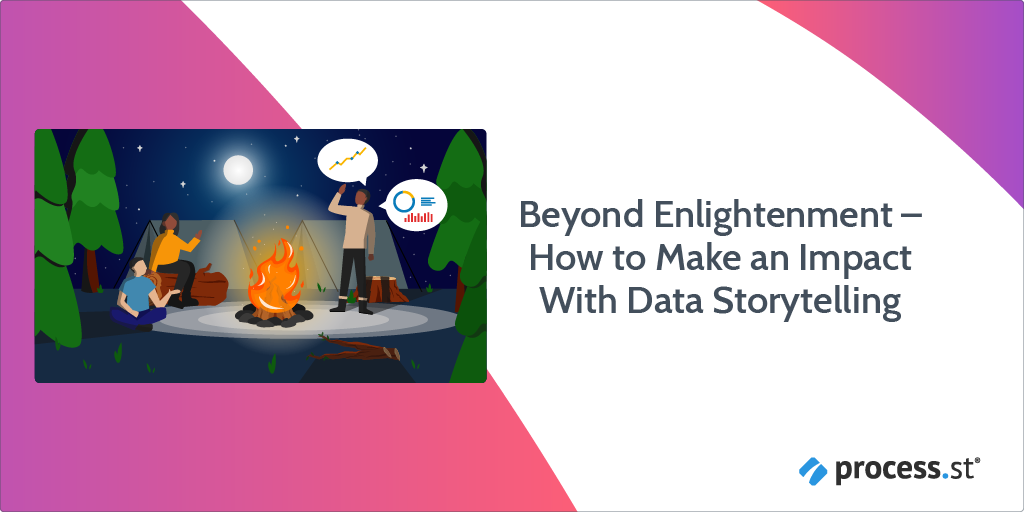
This is a guest post by Brian Skewes, a technologist into deconstruction. Over two decades of self-employment, he has accumulated a wealth of inadvertent real-world lessons related to building, running, and preserving a small company.
There’s a phrase that’s become popular in web analytics, digital marketing, and business consultancy in the last few years: data is everything.
There’s a lot to recommend it. It’s short, snappy, and captures the importance of data to the way in which we do business today. Whether you are building organic links or in the process of drafting an employee development plan, the path to success runs right through a big ‘ol pile of numbers.
Unfortunately, there’s more to numbers than just numbers.
This is due to the nature of data itself. The problem with relying on numbers and nothing else is that no matter how impressive it is, it also remains inscrutable, incomprehensible, or simply boring for the majority of people. Unless your audience is composed entirely of the type of person who can instantly visualize columns of figures, you are going to need to provide some context for the ever-so-impressive stats.
This is where the concept of storytelling comes in.
In this Process Street article, we’ll look at how you can go beyond data acquisition, compilation, and presentation. We’ll show you how to make your data come alive through the magic of storytelling.
- Purposeful data, the Enlightenment, and Single Source of Truth
- Building the framework for your data story
- What’s the story behind your data?
- The happily ever after
Purposeful data, the Enlightenment, and Single Source of Truth
Our starting point is a recently published article by Molly Stovold. In this article, Molly argues that the philosophical and intellectual paradigms of the Enlightenment can be usefully applied to the way in which marketers and analysts work with the data they collect.
Specifically, the idea is that the Enlightenment was a period of profound skepticism (thank you, Descartes), in which truths that were previously regarded as infallible began to be questioned. The existence of God, and even the existence of thought itself, was not taken for granted. And instead of searching for truth in old books (i.e. the Bible), philosophers and scientists turned to a different source: the natural world.
The central idea of the Enlightenment was that every truth could be derived from careful observation of the natural world and that we must remain agnostic about questions that cannot be answered in this way. In other words, we should use what Molly calls a Single Source of Truth (SSOT) as our basis for decisions instead of acting on a hunch, or doing something because you “think it makes sense.”
This might seem a bit abstract in an article ostensibly about storytelling with data but bear with me. To my mind, the most important takeaway from Molly’s article is contained in a quote that she uses about halfway through.
While we should use observation (or data acquisition) to guide our decisions, these data must be interpreted in the light of a scientific or intellectual framework in order to be meaningful. There is a difference, in other words, between data and information.
As Peter Drucker writes in his book Data, Information, and Knowledge, information is “data endowed with relevance and purpose.”
There are many ways to perform this “endowment,” of course. Depending on the question you are seeking to answer, the same data can be interpreted in many different ways. Data that describes the way in which your customers interact with your website, for instance, can be used to inform different parts of your business and will be viewed in a completely different way if you are looking to assess the success of a recent marketing campaign or seeking to optimize software testing.
Building the framework for your data story
The main point to take away from all these philosophical ramblings is this: whatever you are looking to achieve with your data, in order to communicate your point effectively, you will need to provide a frame for it. You might have the most exciting numbers in the world, but unless you put them in context, few may understand them.
There are different ways of achieving that understanding. To make a quick point, some people prefer to use data visualization. As I’ll explain shortly, more complex arguments and explanations are better contextualized as part of a narrative. Before we get to the final assembly stage, though, it’s important that you understand the process of turning raw data into information. There are a number of important considerations as you do this:
Think about your audience

The kind of explanation you provide around your data should depend, to a large degree, on who you are talking to. Different audiences have different levels of knowledge and expertise when it comes to looking at data, and are also used to being talked to in a particular way. It can be useful, here, to think of your audience as one of the following categories:
- Novice: First exposure to the subject, but doesn’t want oversimplification.
- Generalist: Aware of the topic, but looking for an overview understanding and major themes.
- Managerial: In-depth, actionable understanding of intricacies and interrelationships with access to detail.
- Expert: More exploration and discovery and less storytelling with great detail.
- Executive: Only has time to glean the significance and conclusions of weighted probabilities.
Be honest
Secondly, respect both the audience and your data. You might think that, via some “creative” approaches to data visualization, you can make your data more impressive. In reality, the efficacy of data presentation schemes is proportional to their veracity. Ultimately, you are seeking to present data to your audience in a way that makes it clearer and doesn’t introduce bias.
Similarly, don’t be tempted to censor your data. If you do this, you can be guaranteed that your “white lie” will be recognized at some point, and that this will then undermine trust in your work as a whole. If in doubt, leave it in.
Make it human
Finally, make sure that you relate the data you are trying to communicate back to the people who generated it and whose behavior it describes. In some contexts, this is easier said than done, especially if your data relates to the performance of software entities. However, it’s important that the (presumably human) audience you are communicating with can understand what your data means for them.
As an example, if you’re the kind of person who still gleefully and perhaps obliviously uses Google despite its reputation as a data collection tool for advertising companies, be aware that the kind of information sometimes surreptitiously collected from its search engine is the lifeblood of the company’s business model, because it can be used to target advertising to incredibly specific sets of people. Because of this, Google goes to great efforts to construct a series of “personas” that describe the kind of people who can be reached by relating the raw data to relatable characters.
When a company like Google does a thing a certain way, it’s safe to assume that there’s a reason. It works.
What’s the story behind your data?

With these considerations in mind, you’re ready to begin to craft a process to get your message across. As I’ve mentioned above, the best way depends on the type and complexity of the point you want to make. For short, small arguments, it’s probably advisable to use some form of data visualization. However, if the point you want to make is a complex one, get ready to engage your storytelling chops.
There are a number of reasons for this, but the most intuitive is that your method of uncovering the data you present is likely, in itself, to be a narrative one. In other words, the data was generated in order to answer a particular question.
This is where it all comes full circle, back to the ideas that underpin the Enlightenment.
The Englightenment and the quest
The kind of skepticism I mentioned in the first part of this article is directly related to another great product of the Enlightenment, and perhaps its most lasting legacy – the scientific method. Because Enlightenment philosophers could no longer rely on scripture or a hunch to provide the truth, they had to design experiments to uncover it. Some of these experiments – such as Benjamin Franklin’s kite experiment – make great stories in themselves.
That’s not an accident.
Stories of scientific curiosity make great narratives because they follow one of the oldest types of story there is – the quest. This type of story is familiar to all of us, because it is one of the first types of stories we come across as children. A valiant knight leaves his castle and travels across the countryside in order to rescue damsels in distress and find riches, in no particular order.
The story of your data is likely to be the same. Except the riches you’ve found are the answers to your initial questions, and the knight is … well … you.
There are, of course, a variety of ways to construct an effective story, but if you are relatively new to the process, it’s best to stick to a genre of story that is easy to understand and which your audience already has a familiarity with. That way, the mapping between the data you are presenting and the story you tell is clear.
Constructing your story
Once you’ve decided to take this approach, and to use your data to tell a story, you can look at the rules that have been written down by the master storytellers of the last 20 centuries, and use them to inform the way you communicate your own story.
Among the most influential of these, and one of the oldest, have been the rules set down by Aristotle in 350BC. He defined seven elements that a storyteller must think about, and which you should also when looking to communicate the meaning behind your data:
- Plot: The way that the internal logic of your story progresses. You should start with a problem, and then work logically toward a conclusion.
- Characters: This is where personalizing the story, as I’ve mentioned above, comes in: who is the hero?
- Theme: This is the “genre” of the story, but in the case of data communication is likely to be the visual and auditory means through which you tell the story.
- Diction: This is the tone of voice you use to tell the story. Expect it to vary depending on the type of audience you are talking to.
- Melody: For Aristotle, it was important that stories have recognizable musical themes. While you won’t write an opera to communicate your findings, it can be useful to apply this insight by making sure that the materials you produce have a consistent style and tone.
- Decor: Similarly, make sure that your story is presented in a way that is visually attractive to your audience.
- Spectacle: Last but definitely not least, provide a spectacular climax to your story.
Work through these ancient rules and you’ll be well on your way to turning your data into a compelling story that will easily communicate key findings.
The happily ever after
Storytelling is one of the most powerful tools we have to communicate with each other. It can be one of the most effective ways to get across complex ideas in an understandable, succinct form. In addition, because almost everyone is exposed to stories from an early age, it is as close to a universal experience as you will find. Stories have a natural affinity with this form that can help overcome the aversion felt by most people who aren’t data scientists towards data.
This rebirth and new use of an old idea is the reason storytelling has become so popular in almost every field of business over the past few years, and why our recent analysis of business proposals found it to be so prevalent in today’s business environment. So while data may still be king, it takes a bard to tell its story and give it meaning.
What’s your data story? Let us know in the comments below!







Leks Drakos
Leks Drakos, Ph.D. is a rogue academic with a PhD from the University of Kent (Paris and Canterbury). Research interests include HR, DEIA, contemporary culture, post-apocalyptica, and monster studies. Twitter: @leksikality [he/him]